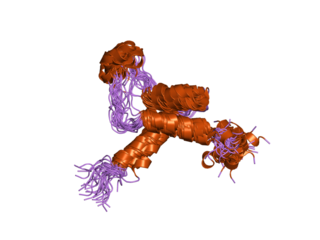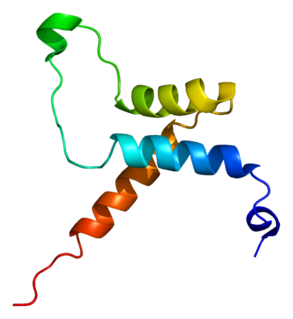Related Research Articles

A homeobox is a DNA sequence, around 180 base pairs long, found within genes that are involved in the regulation of patterns of anatomical development (morphogenesis) in animals, fungi, plants, and numerous single cell eukaryotes. Homeobox genes encode homeodomain protein products that are transcription factors sharing a characteristic protein fold structure that binds DNA to regulate expression of target genes. Homeodomain proteins regulate gene expression and cell differentiation during early embryonic development, thus mutations in homeobox genes can cause developmental disorders.

CCAAT-enhancer-binding proteins is a family of transcription factors composed of six members, named from C/EBPα to C/EBPζ. They promote the expression of certain genes through interaction with their promoters. Once bound to DNA, C/EBPs can recruit so-called co-activators that in turn can open up chromatin structure or recruit basal transcription factors.
Prickle is also known as REST/NRSF-interacting LIM domain protein, which is a putative nuclear translocation receptor. Prickle is part of the non-canonical Wnt signaling pathway that establishes planar cell polarity. A gain or loss of function of Prickle1 causes defects in the convergent extension movements of gastrulation. In epithelial cells, Prickle2 establishes and maintains cell apical/basal polarity. Prickle1 plays an important role in the development of the nervous system by regulating the movement of nerve cells.

TEAD2, together with TEAD1, defines a novel family of transcription factors, the TEAD family, highly conserved through evolution. TEAD proteins were notably found in Drosophila (Scalloped), C. elegans, S. cerevisiae and A. nidulans. TEAD2 has been less studied than TEAD1 but a few studies revealed its role during development.
POU is a family of proteins that have well-conserved homeodomains.

Transducin-like enhancer protein 1 is a protein that in humans is encoded by the TLE1 gene.

Transcription factor HES1 is a protein that is encoded by the Hes1 gene, and is the mammalian homolog of the hairy gene in Drosophila. HES1 is one of the seven members of the Hes gene family (HES1-7). Hes genes code nuclear proteins that suppress transcription.

Insulin gene enhancer protein ISL-1 is a protein that in humans is encoded by the ISL1 gene.

Achaete-scute homolog 1 is a protein that in humans is encoded by the ASCL1 gene. Because it was discovered subsequent to studies on its homolog in Drosophila, the Achaete-scute complex, it was originally named MASH-1 for mammalian achaete scute homolog-1.

Transcriptional enhancer factor TEF-1 also known as TEA domain family member 1 (TEAD1) and transcription factor 13 (TCF-13) is a protein that in humans is encoded by the TEAD1 gene. TEAD1 was the first member of the TEAD family of transcription factors to be identified.

POU domain, class 4, transcription factor 1 (POU4F1) also known as brain-specific homeobox/POU domain protein 3A (BRN3A), homeobox/POU domain protein RDC-1 or Oct-T1 is a protein that in humans is encoded by the POU4F1 gene.

Rhombotin-1 is a protein that in humans is encoded by the LMO1 gene.

Homeobox protein OTX2 is a protein that in humans is encoded by the OTX2 gene.

Paired related homeobox 1 is a protein that in humans is encoded by the PRRX1 gene.

Transducin-like enhancer protein 2 is a protein that in humans is encoded by the TLE2 gene.

Homeobox protein Emx2 is a protein that in humans is encoded by the EMX2 gene.
Neurogenins are a family of bHLH transcription factors involved in specifying neuronal differentiation. It is one of many gene families related to the atonal gene in Drosophila. Other positive regulators of neuronal differentiation also expressed during early neural development include NeuroD and ASCL1.

Homeobox protein OTX1 is a protein that in humans is encoded by the OTX1 gene.

LIM homeobox transcription factor 1, alpha, also known as LMX1A, is a protein which in humans is encoded by the LMX1A gene.
Proneural genes encode transcription factors of the basic helix-loop-helix (bHLH) class which are responsible for the development of neuroectodermal progenitor cells. Proneural genes have multiple functions in neural development. They integrate positional information and contribute to the specification of progenitor-cell identity. From the same ectodermal cell types, neural or epidermal cells can develop based on interactions between proneural and neurogenic genes. Neurogenic genes are so called because loss of function mutants show an increase number of developed neural precursors. On the other hand, proneural genes mutants fail to develop neural precursor cells.
References
- ↑ Jurata LW, Kenny DA, Gill GN (October 1996). "Nuclear LIM interactor, a rhombotin and LIM homeodomain interacting protein, is expressed early in neuronal development". Proc. Natl. Acad. Sci. U.S.A. 93 (21): 11693–8. Bibcode:1996PNAS...9311693J. doi: 10.1073/pnas.93.21.11693 . PMC 38120 . PMID 8876198.
- ↑ Bach I, Carriere C, Ostendorff HP, Andersen B, Rosenfeld MG (June 1997). "A family of LIM domain-associated cofactors confer transcriptional synergism between LIM and Otx homeodomain proteins". Genes Dev. 11 (11): 1370–80. doi: 10.1101/gad.11.11.1370 . PMID 9192866.
- 1 2 3 Morcillo P, Rosen C, Baylies MK, Dorsett D (October 1997). "Chip, a widely expressed chromosomal protein required for segmentation and activity of a remote wing margin enhancer in Drosophila". Genes Dev. 11 (20): 2729–40. doi:10.1101/gad.11.20.2729. PMC 316608 . PMID 9334334.